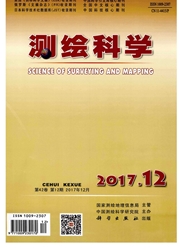

 中文摘要:
中文摘要:
本文介绍了基于国际探月观测数据建立的月球重力场模型:8×4、15×8、13×13、5×5、7×7、16×16—1/2/3、Lun60d、GLGM-1/2、LP75D/G、LP100K/J、LP165P、LP150Q和SGM90d;通过对比SST—HIMLL—Doppler.VLBI和SST—HIMSGG.Doppler—VLBI跟踪观测模式的优缺点,建议我国将来首期月球卫星重力测量计划采用SST—HL/SGG—Doppler.VLBI较优;其次,通过对比静电悬浮、超导和量子卫星重力梯度仪的优缺点,建议我国将来首期月球卫星重力梯度计划采用静电悬浮重力梯度仪;并建议我国将来首颗月球重力梯度卫星的轨道高度(50~100km)选择在已有月球探测卫星的测量盲区,轨道倾角(90°±3°)设计为有利于月球卫星观测数据全球覆盖的近极轨模式。
 英文摘要:
英文摘要:
In the paper, firstly, the lunar gravitational field models produced by observations of lunar exploration including 8×4、15×8、13×13、5×5、7×7、16×16-1/2/3、Lun60d、GLGM-1/2、LP75D/G、LP100K/J、LP165P、LP150Q and SGM90d were expatiated; secondly, SST-HL/SGG-Doppler-VLBI tracking mode was suggested in the future first-stage lunar satellite gravity measurement in China by a comparison of strongpoints and shortcomings between SST-HL/LL-Doppler-VLBI and SST-HL/SGG- Doppler-VLBI modes; thirdly, the electrostatic suspension gravity gradiometer was a preferable selection in the future first-stage lunar satellite gravity gradiometry mission in China by a comparison of advantages and disadvantages among electrostatic suspension, super- conducting and quantum gravity gradiometers. Finally, the orbital altitude (50 -100 km) of lunar gravity gradiometry satellite was se- lected in the unmeasurable area of existing lunar satellites and orbital inclination (90°±3°) was designed as the near-polar-orbit model for global coverage of lunar satellite observations in China.
 同期刊论文项目
同期刊论文项目
 同项目期刊论文
同项目期刊论文
 Precise and rapid recovery of the Earths gravitational field by the next-generation four-satellite c
Precise and rapid recovery of the Earths gravitational field by the next-generation four-satellite c Precise and rapid recovery of Earths gravity field from next-generation GRACE Follow-On mission usin
Precise and rapid recovery of Earths gravity field from next-generation GRACE Follow-On mission usin Precise Recovery of the Earths Gravitational Field With GRACE: Intersatellite Range-Rate Interpolati
Precise Recovery of the Earths Gravitational Field With GRACE: Intersatellite Range-Rate Interpolati Accurate and rapid determination of GOCE Earths gravitational field using time-space-wise approach a
Accurate and rapid determination of GOCE Earths gravitational field using time-space-wise approach a 期刊信息
期刊信息
